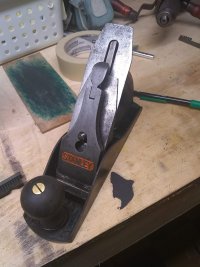I came across some mention that wood releases some acidity over time. Seems like that is indeed the case:
 www.vam.ac.uk
www.vam.ac.uk
This is concerning to me as my brother's woodworking hobby has been my go-to for scales and I like the linseed oil / beeswax finish he uses because it doesn't make the wood look and feel as plasticky as a shiny CA or urethane type coating. But maybe this is a bad idea and the oil/wax is insufficient to prevent acid from the wood from harming my blades over time?
I don't think it'll be a problem during my life as I store them carefully with VCI paper, don't let humidity build up, and I enjoy rotating through my collection so I'll catch it early if any corrosion develops.
I'm more concerned that I'm strapping nice blades to something mildly corrosive that will potentially hasten their demise if, after I'm gone, they wind up tossed in a box and stored without particular care for a few decades before being discovered again by someone who will appreciate them. Am I doing them a disservice with my choice of material? On the other hand, I've found some old blades with wood scales that seem to have survived quite some time without attention so probably it's a non-issue? Better than celluloid at any rate! Perhaps the porosity of the wood can help too in that it can absorb small increases in humidity from temperature changes?
Still, it seems this might be worth looking into and thinking about further. If nothing else, it's motivating me to take this into consideration when choosing the type of wood. Oak is apparently particularly acidic for example so now I'm going to investigate further in case I should hold off on some planned walnut scales...
Example of the linseed oil / beeswax finish:

Corrosion of metals associated with wood - Victoria and Albert Museum
Wood and metal are usually regarded as highly compatible materials. However, interactions between certain metals and woods can take place under adverse conditions, or as a result of using unsuitable materials.
This is concerning to me as my brother's woodworking hobby has been my go-to for scales and I like the linseed oil / beeswax finish he uses because it doesn't make the wood look and feel as plasticky as a shiny CA or urethane type coating. But maybe this is a bad idea and the oil/wax is insufficient to prevent acid from the wood from harming my blades over time?
I don't think it'll be a problem during my life as I store them carefully with VCI paper, don't let humidity build up, and I enjoy rotating through my collection so I'll catch it early if any corrosion develops.
I'm more concerned that I'm strapping nice blades to something mildly corrosive that will potentially hasten their demise if, after I'm gone, they wind up tossed in a box and stored without particular care for a few decades before being discovered again by someone who will appreciate them. Am I doing them a disservice with my choice of material? On the other hand, I've found some old blades with wood scales that seem to have survived quite some time without attention so probably it's a non-issue? Better than celluloid at any rate! Perhaps the porosity of the wood can help too in that it can absorb small increases in humidity from temperature changes?
Still, it seems this might be worth looking into and thinking about further. If nothing else, it's motivating me to take this into consideration when choosing the type of wood. Oak is apparently particularly acidic for example so now I'm going to investigate further in case I should hold off on some planned walnut scales...
Example of the linseed oil / beeswax finish:





